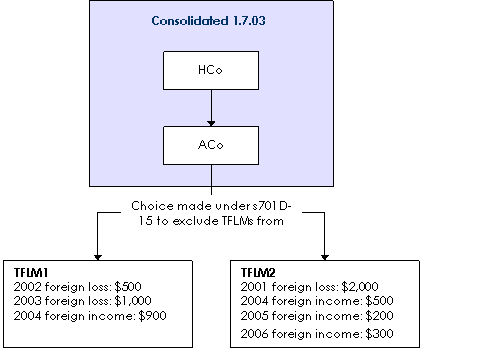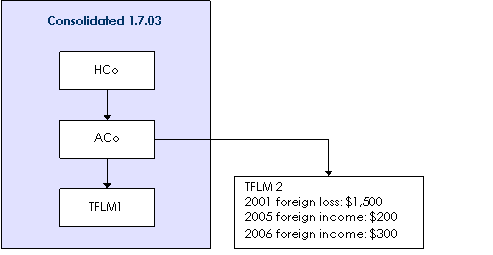Consolidation Reference Manual
You can still refer to the Consolidation reference manual for consolidation information that has not been impacted by changes in the legislation.
C3 Losses
C3-4 Worked example - loss utilisation
Utilisation - special circumstances
C3-4-550 Transitional foreign loss makers
Description
This example shows how the transitional foreign loss maker provisions in Division 701D of the Income Tax (Transitional Provisions) Act 1997 (IT(TP)A) apply.
Commentary
The transitional foreign loss maker provisions allow an entity that has foreign losses to remain outside a consolidated group for a period of up to three years, or until its foreign losses are utilised, as opposed to being subject to the loss utilisation regime of Subdivision 707-C of the ITAA 1997.
The excluded entity is called a 'transitional foreign loss maker'. The time that it is excluded from the group is the 'transitional time,'
A head company of a consolidated group [F1] can choose to exclude an entity from the group for a transitional time if the conditions in section 701D-10 of the IT(TP)A are satisfied:
- •
- the group forms before 1 July 2004
- •
- the transitional time is not later than three years after the group forms
- •
- the transitional foreign loss maker would otherwise be a subsidiary member of the group at the transitional time
- •
- the transitional foreign loss maker is a wholly-owned subsidiary of the head company throughout the period from the start of 1 July 2002 to the transitional time → the 'continuous ownership condition', subsection 701D-10(2)
- •
- the transitional foreign loss maker incurred an overall foreign loss
[F2]
in the 2001-02 income year or earlier and this loss:
- -
- remains unutilised in any income year ending before the transitional time
- -
- is one that would have been transferred [F3] to the head company had the transitional foreign loss maker become a subsidiary member of the consolidated group at the formation time, and
- → the 'foreign loss condition', subsection 701D-10(3)
- •
- the transitional foreign loss maker does not hold a membership interest in another entity that, but for these provisions, would be a subsidiary member of the consolidated group → the 'no-subsidiary condition', subsection 701D-10(4).
The head company must notify the Tax Office, in accordance with section 701D-15 of the IT(TP)A, that it has chosen to exclude the transitional foreign loss maker from the consolidated group. The notification must be made by the later of 30 July 2004 and the date of lodgement of the head company's first consolidated return (or if a return is not required, the date it would otherwise have been due). The choice cannot be revoked. → subsections 701D-15(3) and (4), IT(TP)A 1997
Although the transitional foreign loss maker is excluded from the consolidated group, it remains a member of the relevant consolidatable group. This means that it cannot, while it is outside the group, be the recipient company or originating company in a roll-over under Subdivision 126-B, ITAA 1997. Nor can it participate in a transfer of a tax loss or capital loss between companies under Division 170, ITAA 1997 or choose to have treated as part of itself an Australian branch of a foreign bank under the thin capitalisation rules. → subsection 701D-10(5), IT(TP)A 1997
Example
Facts
A wholly-owned group consists of a head company (HCo) and three subsidiaries, ACo, TFLM1 and TFLM2. The group existed before 1 July 2002. HCo elects to form a consolidated group from 1 July 2003 (within the transitional period) and makes the choice to exclude TFLM1 and TFLM2 from the consolidated group under section 701D-15 of the IT(TP)A.
As at 1 July 2003 (commencement of the transitional time) all of the conditions outlined in section 701D-10 of the IT(TP)A are satisfied.
Table 1 shows the foreign income and losses of the two transitional foreign loss makers for the income years 2001-2006.
| 2001 | 2002 | 2003 | 2004 | 2005 | 2006 | ||
|---|---|---|---|---|---|---|---|
| TFLM1 | |||||||
| Unrecouped foreign loss | - | $500 | $1,000 | - | - | - | |
| Foreign income | - | - | - | $900 | - | - | |
| TFLM2 | |||||||
| Unrecouped foreign loss | $2,000 | - | - | - | - | - | |
| Foreign income | - | - | - | $500 | $200 | $300 | |
Note: For each transitional foreign loss maker, all foreign losses and foreign income are of the same class.
Figure 1: Exclusion of transitional foreign loss makers

Calculation
TFLM1
In the year ended 30 June 2004, TFLM1 fully recoups the 2002 foreign loss of $500. The 2003 foreign loss is partially utilised to the extent of $400 and the remaining $600 is carried forward to the 2005 income year. As TFLM1 has fully recouped its 2002 foreign loss, it no longer satisfies the foreign loss condition. Therefore, the transitional time ends before the maximum three years allowed under the provisions, and TFLM1 must become a member of the consolidated group from 1 July 2004.
The remaining $600 is transferred to HCo at the joining time, provided the transfer tests [F4] are satisfied.
TFLM2
This company does not fully recoup its 2001 foreign loss of $2,000 before 1 July 2006. Assuming that all of the conditions in section 701D-10 of the IT(TP)A continue to be satisfied, TFLM2 remains outside the consolidated group for the maximum three-year transitional time, until 30 June 2006. TFLM2 becomes a member of the consolidated group on 1 July 2006. The unrecouped foreign loss of $1,000 is transferred to HCo at the joining time, provided the transfer tests are satisfied. [F5]
Figure 2: TFLM1 joins consolidated group 1.7.04

Losses that are transferred to the head company trigger an adjustment to existing available fractions (if any) in the consolidated group.
→ 'Adjusting available fraction - another loss entity joins the group', C3-4-330
This adjustment can be avoided if the head company chooses to cancel the transfer of the unutilised foreign loss → section 707-145. Losses that are not transferred to the head company cannot be utilised by any entity for an income year ending after the joining time → section 707-150.
Transitional period concessions
As TFLM1 was excluded from the consolidated group for a period prior to joining the group, it is not eligible for any of the transitional concessions → Subdivision 707-C. These concessions are only available to entities that become members of a group at the formation time.
References
Income Tax (Transitional Provisions) Act 1997 - as amended by Taxation Laws Amendment Act (No. 1) 2004 :
Income Tax Assessment Act 1997 :
Income Tax Assessment Act 1936 :
- •
- Section 160AFD
Explanatory Memorandum to Taxation Laws Amendment Bill (No. 7) 2003, Chapter 4
History
Revision History
Section C3-4-550 first published 10 December 2004.
Further revisions are described below.
| Date | Amendment | Reason |
|---|---|---|
| 26.10.05 | Reference to notification requirement, p. 2. | Legislative amendments. |
Proposed changes to consolidation
Proposed changes to consolidation announced by the Government are not incorporated into the Consolidation reference manual until they become law.
In the interim, information about such changes can be viewed at:
- •
- http://assistant treasurer.gov.au (Assistant Treasurer's press releases)
- •
- www.treasury.gov.au (Treasury papers on refinements to the consolidation regime).
Current at 26 October 2005
Includes a MEC group. Refer to section 719-15 which has the effect of modifying subsection 701D-10(2) of the IT(TP)A with respect to a MEC group.
As defined in section 160AFD of the Income Tax Assessment Act 1936.
After satisfying relevant transfer tests in Subdivision 707-A of the ITAA 1997.
Subdivision 707-A, ITAA 1997.
Subdivision 707-A, ITAA 1997.
